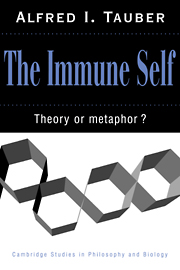Book contents
- Frontmatter
- Contents
- Acknowledgments
- Introduction
- 1 The phagocytosis theory
- 2 The triumph of immunology
- 3 The immune self declared
- 4 From theory to metaphor
- 5 Immunology gropes for its theory
- 6 The self and the phenomenological attitude
- 7 The self as organism: A philosophical consideration
- 8 The search for identity
- Notes
- References
- Index
3 - The immune self declared
Published online by Cambridge University Press: 14 January 2010
- Frontmatter
- Contents
- Acknowledgments
- Introduction
- 1 The phagocytosis theory
- 2 The triumph of immunology
- 3 The immune self declared
- 4 From theory to metaphor
- 5 Immunology gropes for its theory
- 6 The self and the phenomenological attitude
- 7 The self as organism: A philosophical consideration
- 8 The search for identity
- Notes
- References
- Index
Summary
FRANK MACFARLANE BURNET, PROTOIMMUNOLOGIST
The concern with arriving at a science of immunology that addresses both the pathogen challenge and the surveillance of normal /abnormal body economy expanded immunology into the science of self /not-self discrimination. In this narrative I have so far scrupulously avoided using the term self as noun, but now we are prepared to evaluate critically how it entered the language of immunology and consider what its conceptual utility has been. The concept of the self was formally inaugurated into immunology by Sir Frank Macfarlane Burnet (Figure 2). In the second edition of,The Production of Antibodies (1949), Burnet and Frank Fenner introduced the “self-marker ” hypothesis, which eventually evolved into the theory that tolerance is a result of the elimination of lymphocytes reactive to autologous constituents:
It is an obvious physiological necessity and a fact fully established by experiment that the body's own cells should not provoke antibody formation. Minor exceptions to this rule concern only tissues which are “unexpendable” parts of the central nervous system and the eye. An animal's own red cells are non-antigenic. This is not due to any intrinsic absence of antigenic components; the same cells injected into a different species or even into another unrelated animal of the same species may give rise to active antibody production. The failure of antibody production against autologous cells demands the postulation of an active ability of the reticulo-endothelial cells to recognize “self” pattern from “not-self” pattern in organic material taken into their substance. […]
- Type
- Chapter
- Information
- The Immune SelfTheory or Metaphor?, pp. 81 - 123Publisher: Cambridge University PressPrint publication year: 1994



